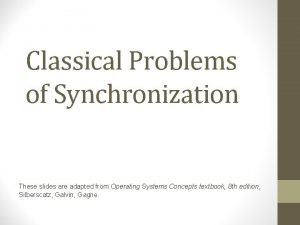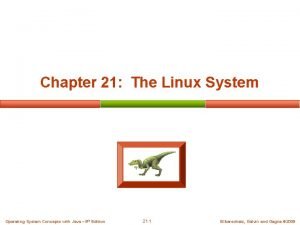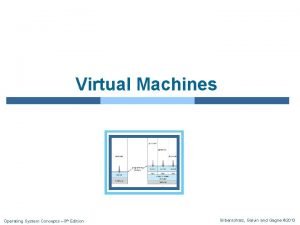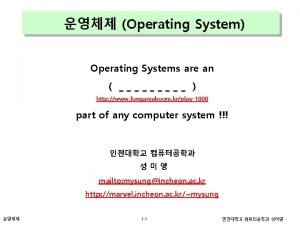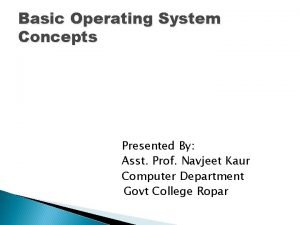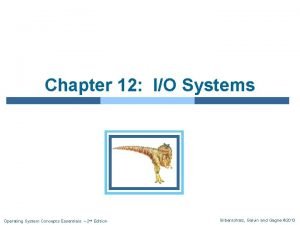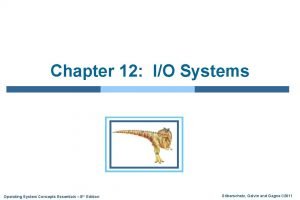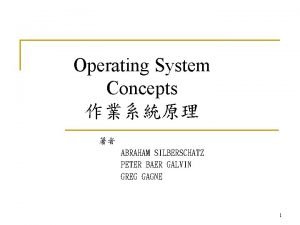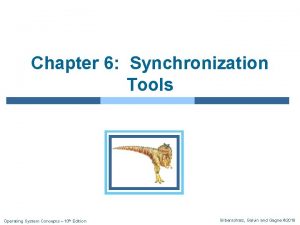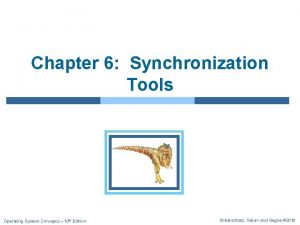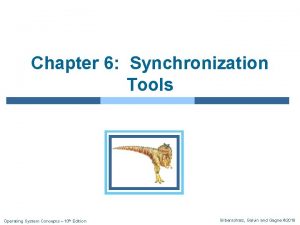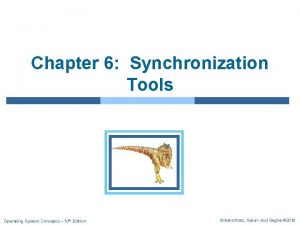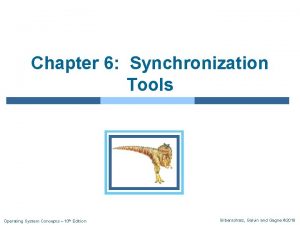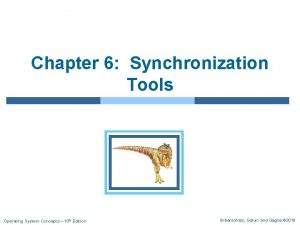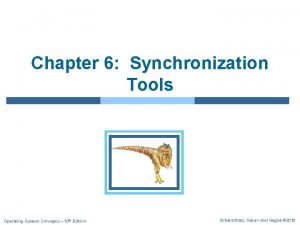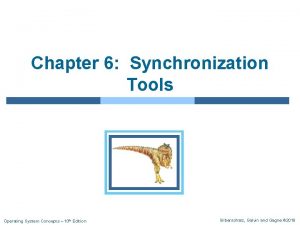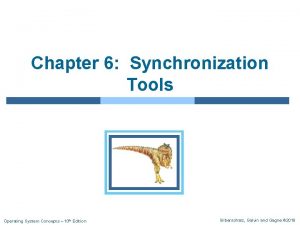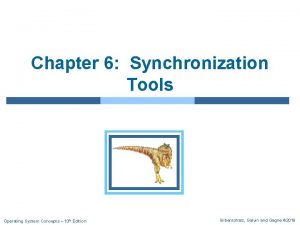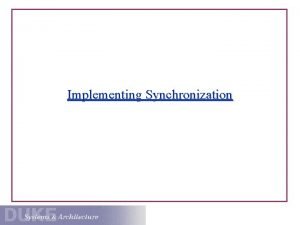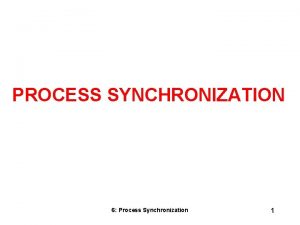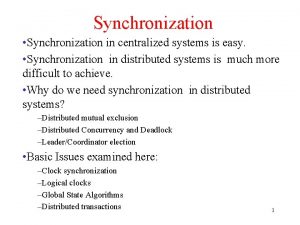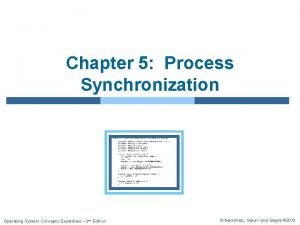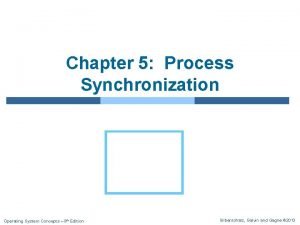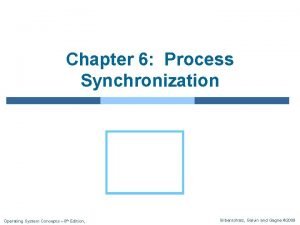Chapter 6 Synchronization Tools Operating System Concepts 10














![Algorithm for Process Pi do { flag[i] = true; turn = j; while (flag[j] Algorithm for Process Pi do { flag[i] = true; turn = j; while (flag[j]](https://slidetodoc.com/presentation_image_h2/72c764bd91c82b464d7a8650f0255d7a/image-15.jpg)







![Bounded-waiting Mutual Exclusion with test_and_set do { waiting[i] = true; key = true; while Bounded-waiting Mutual Exclusion with test_and_set do { waiting[i] = true; key = true; while](https://slidetodoc.com/presentation_image_h2/72c764bd91c82b464d7a8650f0255d7a/image-23.jpg)



- Slides: 26

Chapter 6: Synchronization Tools Operating System Concepts – 10 th Edition Silberschatz, Galvin and Gagne © 2018

Chapter 6: Synchronization Tools n n n n Background The Critical-Section Problem Peterson’s Solution Synchronization Hardware Mutex Locks Semaphores Monitors Operating System Concepts – 10 th Edition 6. 2 Silberschatz, Galvin and Gagne © 2018

Objectives n To present the concept of process synchronization. n To introduce the critical-section problem, whose solutions can be used to ensure the consistency of shared data n To present both software and hardware solutions of the critical-section problem n To examine several classical process-synchronization problems n To explore several tools that are used to solve process synchronization problems Operating System Concepts – 10 th Edition 6. 3 Silberschatz, Galvin and Gagne © 2018

Background n Processes can execute concurrently l May be interrupted at any time, partially completing execution n Concurrent access to shared data may result in data inconsistency n Maintaining data consistency requires mechanisms to ensure the orderly execution of cooperating processes n Illustration of the problem: Suppose that we wanted to provide a solution to the consumer -producer problem that fills all the buffers. We can do so by having an integer counter that keeps track of the number of full buffers. Initially, counter is set to 0. It is incremented by the producer after it produces a new buffer and is decremented by the consumer after it consumes a buffer. Operating System Concepts – 10 th Edition 6. 4 Silberschatz, Galvin and Gagne © 2018

Producer while (true) { /* produce an item in next produced */ while (counter == BUFFER_SIZE) ; /* do nothing */ buffer[in] = next_produced; in = (in + 1) % BUFFER_SIZE; counter++; } Operating System Concepts – 10 th Edition 6. 5 Silberschatz, Galvin and Gagne © 2018

Consumer while (true) { while (counter == 0) ; /* do nothing */ next_consumed = buffer[out]; out = (out + 1) % BUFFER_SIZE; counter--; /* consume the item in next consumed */ } Operating System Concepts – 10 th Edition 6. 6 Silberschatz, Galvin and Gagne © 2018

Race Condition n counter++ could be implemented as register 1 = counter register 1 = register 1 + 1 counter = register 1 n counter-- could be implemented as register 2 = counter register 2 = register 2 - 1 counter = register 2 n n Consider this execution interleaving with “count = 5” initially: S 0: producer execute register 1 = counter S 1: producer execute register 1 = register 1 + 1 S 2: consumer execute register 2 = counter S 3: consumer execute register 2 = register 2 – 1 S 4: producer execute counter = register 1 S 5: consumer execute counter = register 2 {register 1 = 5} {register 1 = 6} {register 2 = 5} {register 2 = 4} {counter = 6 } {counter = 4} race condition: several threads access and manipulate the same data concurrently, and where the outcome of the execution depends on the particular order of access. Operating System Concepts – 10 th Edition 6. 7 Silberschatz, Galvin and Gagne © 2018

Controlling race conditions n Synchronization: using atomic operations to ensure cooperation between threads. n Mutual exclusion: ensuring that only one thread does a particular thing at a time. l n One thread doing it excludes the other, and vice versa. Critical section: piece of code that only one thread can execute at once. l Only one thread at a time will get into the section of code. Operating System Concepts – 10 th Edition 6. 8 Silberschatz, Galvin and Gagne © 2018

Critical Section Problem n Consider system of n processes {p 0, p 1, … pn-1} n Each process has critical section segment of code l Process may be changing common variables, updating table, writing file, etc l When one process in critical section, no other may be in its critical section n Critical section problem is to design protocol to solve this n Each process must ask permission to enter critical section in entry section, may follow critical section with exit section, then remainder section Operating System Concepts – 10 th Edition 6. 9 Silberschatz, Galvin and Gagne © 2018

Critical Section n General structure of process Pi Operating System Concepts – 10 th Edition 6. 10 Silberschatz, Galvin and Gagne © 2018

Algorithm for Process Pi do { while (turn == j); critical section turn = j; remainder section } while (true); Operating System Concepts – 10 th Edition 6. 11 Silberschatz, Galvin and Gagne © 2018

Solution to Critical-Section Problem 1. Mutual Exclusion - If process Pi is executing in its critical section, then no other processes can be executing in their critical sections 2. Progress - If no process is executing in its critical section and there exist some processes that wish to enter their critical section, then the selection of the processes that will enter the critical section next cannot be postponed indefinitely 3. Bounded Waiting - A bound must exist on the number of times that other processes are allowed to enter their critical sections after a process has made a request to enter its critical section and before that request is granted Assume that each process executes at a nonzero speed No assumption concerning relative speed of the n processes Operating System Concepts – 10 th Edition 6. 12 Silberschatz, Galvin and Gagne © 2018

Critical-Section Handling in OS Two approaches depending on if kernel is preemptive or nonpreemptive l Preemptive – allows preemption of process when running in kernel mode l Non-preemptive – runs until exits kernel mode, blocks, or voluntarily yields CPU 4 Essentially free of race conditions in kernel mode Operating System Concepts – 10 th Edition 6. 13 Silberschatz, Galvin and Gagne © 2018

Peterson’s Solution n Good algorithmic description of solving the problem n Two process solution Assume that the load and store machine-language instructions are atomic; that is, cannot be interrupted n The two processes share two variables: n l l int turn; Boolean flag[2] The variable turn indicates whose turn it is to enter the critical section n The flag array is used to indicate if a process is ready to enter the critical section. flag[i] = true implies that process Pi is ready! n Operating System Concepts – 10 th Edition 6. 14 Silberschatz, Galvin and Gagne © 2018
![Algorithm for Process Pi do flagi true turn j while flagj Algorithm for Process Pi do { flag[i] = true; turn = j; while (flag[j]](https://slidetodoc.com/presentation_image_h2/72c764bd91c82b464d7a8650f0255d7a/image-15.jpg)
Algorithm for Process Pi do { flag[i] = true; turn = j; while (flag[j] && turn = = j); critical section flag[i] = false; remainder section } while (true); Operating System Concepts – 10 th Edition 6. 15 Silberschatz, Galvin and Gagne © 2018

Peterson’s Solution (Cont. ) n Provable that the three Critical Section requirements are met: 1. Mutual exclusion is preserved Pi enters CS only if: either flag[j] = false or turn = i 2. Progress requirement is satisfied 3. Bounded-waiting requirement is met Operating System Concepts – 10 th Edition 6. 16 Silberschatz, Galvin and Gagne © 2018

Synchronization Hardware Many systems provide hardware support for implementing the critical section code. n All solutions below based on idea of locking l Protecting critical regions via locks n Uniprocessors – could disable interrupts l Currently running code would execute without preemption l Generally too inefficient on multiprocessor systems 4 Operating systems using this not broadly scalable n Modern machines provide special atomic hardware instructions 4 Atomic = non-interruptible n l l Either test memory word and set value Or swap contents of two memory words Operating System Concepts – 10 th Edition 6. 17 Silberschatz, Galvin and Gagne © 2018

Solution to Critical-section Problem Using Locks do { acquire lock critical section release lock remainder section } while (TRUE); Operating System Concepts – 10 th Edition 6. 18 Silberschatz, Galvin and Gagne © 2018

test_and_set Instruction Definition: boolean test_and_set (boolean *target) { boolean rv = *target; *target = TRUE; return rv: } 1. Executed atomically 2. Returns the original value of passed parameter 3. Set the new value of passed parameter to “TRUE”. Operating System Concepts – 10 th Edition 6. 19 Silberschatz, Galvin and Gagne © 2018

Solution using test_and_set() n Shared Boolean variable lock, initialized to FALSE n Solution: do { while (test_and_set(&lock)) ; /* do nothing, busy wait */ /* critical section */ lock = false; /* remainder section */ } while (true); n Busy-waiting: thread consumes CPU cycles while it is waiting. Operating System Concepts – 10 th Edition 6. 20 Silberschatz, Galvin and Gagne © 2018

compare_and_swap Instruction Definition: int compare _and_swap(int *value, int expected, int new_value) { int temp = *value; if (*value == expected) *value = new_value; return temp; } 1. Executed atomically 2. Returns the original value of passed parameter “value” 3. Set the variable “value” the value of the passed parameter “new_value” but only if “value” ==“expected”. That is, the swap takes place only under this condition. Operating System Concepts – 10 th Edition 6. 21 Silberschatz, Galvin and Gagne © 2018

Solution using compare_and_swap n Shared integer “lock” initialized to 0; n Solution: do { while (compare_and_swap(&lock, 0, 1) != 0) ; /* do nothing */ /* critical section */ lock = 0; /* remainder section */ } while (true); Operating System Concepts – 10 th Edition 6. 22 Silberschatz, Galvin and Gagne © 2018
![Boundedwaiting Mutual Exclusion with testandset do waitingi true key true while Bounded-waiting Mutual Exclusion with test_and_set do { waiting[i] = true; key = true; while](https://slidetodoc.com/presentation_image_h2/72c764bd91c82b464d7a8650f0255d7a/image-23.jpg)
Bounded-waiting Mutual Exclusion with test_and_set do { waiting[i] = true; key = true; while (waiting[i] && key) key = test_and_set(&lock); waiting[i] = false; /* critical section */ j = (i + 1) % n; while ((j != i) && !waiting[j]) j = (j + 1) % n; if (j == i) lock = false; else waiting[j] = false; /* remainder section */ } while (true); Operating System Concepts – 10 th Edition 6. 23 Silberschatz, Galvin and Gagne © 2018

Mutex Locks Previous solutions are complicated and generally inaccessible to application programmers n OS designers build software tools to solve critical section problem n n Simplest is mutex lock n Protect a critical section by first acquire() a lock then release() the lock l n Calls to acquire() and release() must be atomic l n Boolean variable indicating if lock is available or not Usually implemented via hardware atomic instructions But this solution requires busy waiting n This lock therefore called a spinlock Operating System Concepts – 10 th Edition 6. 24 Silberschatz, Galvin and Gagne © 2018

acquire() and release() n acquire() { while (!available) ; /* busy wait */ available = false; ; } n release() { available = true; } n do { acquire lock critical section release lock remainder section } while (true); Operating System Concepts – 10 th Edition 6. 25 Silberschatz, Galvin and Gagne © 2018

Semaphore n Synchronization tool that provides more sophisticated ways (than Mutex locks) for process to synchronize their activities. n Semaphore S – non-negative integer variable Can only be accessed via two indivisible (atomic) operations n wait() and signal() 4 Originally called P() and V() Definition of the wait() operation wait(S) { l n while (S <= 0) ; // busy wait, spinlock S--; } n Definition of the signal() operation signal(S) { S++; } Operating System Concepts – 10 th Edition 6. 26 Silberschatz, Galvin and Gagne © 2018
 Synchronization tools in operating system
Synchronization tools in operating system Which one of the following is a synchronization tool?
Which one of the following is a synchronization tool? Classical problem of synchronization in os
Classical problem of synchronization in os Operating system concepts chapter 8 solutions
Operating system concepts chapter 8 solutions Operating system concepts chapter 5 solutions
Operating system concepts chapter 5 solutions Operating system concepts chapter 5 solutions
Operating system concepts chapter 5 solutions Operating system
Operating system Linux operating system concepts
Linux operating system concepts Operating system concepts with java
Operating system concepts with java Operating system concepts 6th edition
Operating system concepts 6th edition Operating system concepts 9
Operating system concepts 9 Realtime operating system
Realtime operating system 교보 drm
교보 drm Basic operating system concepts
Basic operating system concepts Operating system concepts 11th
Operating system concepts 11th Operating system concepts essentials
Operating system concepts essentials Operating system concepts essentials
Operating system concepts essentials Silberschatz operating system concepts
Silberschatz operating system concepts Physical clock synchronization in distributed system
Physical clock synchronization in distributed system Operating systems
Operating systems Buddy system example
Buddy system example File system in operating system
File system in operating system File system in operating system
File system in operating system File system in operating system
File system in operating system Critical thinking concepts
Critical thinking concepts Paul elder model
Paul elder model Dfd chapter 5
Dfd chapter 5


